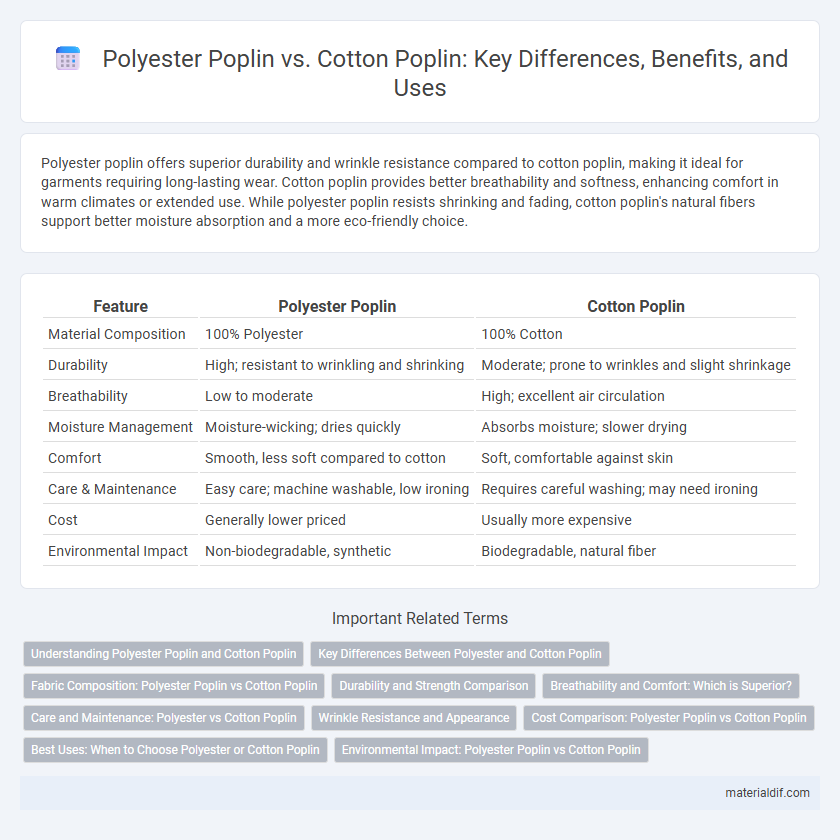Polyester poplin offers superior durability and wrinkle resistance compared to cotton poplin, making it ideal for garments requiring long-lasting wear. Cotton poplin provides better breathability and softness, enhancing comfort in warm climates or extended use. While polyester poplin resists shrinking and fading, cotton poplin's natural fibers support better moisture absorption and a more eco-friendly choice.
Table of Comparison
| Feature | Polyester Poplin | Cotton Poplin |
|---|---|---|
| Material Composition | 100% Polyester | 100% Cotton |
| Durability | High; resistant to wrinkling and shrinking | Moderate; prone to wrinkles and slight shrinkage |
| Breathability | Low to moderate | High; excellent air circulation |
| Moisture Management | Moisture-wicking; dries quickly | Absorbs moisture; slower drying |
| Comfort | Smooth, less soft compared to cotton | Soft, comfortable against skin |
| Care & Maintenance | Easy care; machine washable, low ironing | Requires careful washing; may need ironing |
| Cost | Generally lower priced | Usually more expensive |
| Environmental Impact | Non-biodegradable, synthetic | Biodegradable, natural fiber |
Understanding Polyester Poplin and Cotton Poplin
Polyester poplin offers a smooth, durable fabric known for its wrinkle resistance and moisture-wicking properties, making it ideal for uniforms and outdoor apparel. Cotton poplin provides natural breathability and softness, favored for comfort in shirts and casual wear but requires more care due to its tendency to wrinkle. Both fabrics feature a tight, plain weave with a crisp texture, but polyester's synthetic fibers enhance durability while cotton's natural fibers ensure superior comfort.
Key Differences Between Polyester and Cotton Poplin
Polyester Poplin features a synthetic fiber structure that offers higher durability, wrinkle resistance, and moisture-wicking properties compared to natural Cotton Poplin, which is more breathable and softer against the skin. The key differences lie in fiber composition, with polyester made from petroleum-based polymers and cotton derived from natural cotton fibers, affecting breathability and texture. Polyester Poplin is ideal for long-lasting, low-maintenance garments while Cotton Poplin excels in comfort and natural fiber benefits.
Fabric Composition: Polyester Poplin vs Cotton Poplin
Polyester poplin is composed primarily of synthetic polyester fibers, offering durability, wrinkle resistance, and moisture-wicking properties, while cotton poplin consists of 100% natural cotton fibers, providing breathability and softness. The synthetic nature of polyester poplin allows for greater colorfastness and less shrinkage compared to cotton poplin, which tends to absorb moisture and may shrink after washing. Fabric composition differences impact texture, longevity, and care requirements, making polyester poplin ideal for high-performance and easy-care garments, whereas cotton poplin suits lightweight, breathable clothing with a natural feel.
Durability and Strength Comparison
Polyester poplin offers superior durability and strength compared to cotton poplin, benefiting from synthetic fibers that resist tearing, shrinking, and stretching. The tightly woven polyester fibers maintain fabric integrity under frequent washing and heavy use, making it ideal for long-lasting apparel and upholstery. In contrast, cotton poplin, though breathable and natural, tends to weaken faster with wear and repeated laundering due to its organic fiber composition.
Breathability and Comfort: Which is Superior?
Polyester poplin offers durability and wrinkle resistance but lacks the breathability of cotton poplin, making it less comfortable in hot or humid conditions. Cotton poplin excels in moisture absorption and air circulation, providing superior comfort and breathability for everyday wear. Choosing cotton poplin is ideal for those prioritizing natural fiber comfort, while polyester suits durable, low-maintenance needs.
Care and Maintenance: Polyester vs Cotton Poplin
Polyester poplin requires less maintenance due to its wrinkle resistance and quick-drying properties, making it ideal for low-effort care routines. Cotton poplin demands more frequent ironing and can shrink if not washed properly, requiring careful handling during laundering. The durability of polyester poplin withstands frequent washing without fading, while cotton poplin tends to soften and improve with each wash but may lose color vibrancy over time.
Wrinkle Resistance and Appearance
Polyester poplin exhibits superior wrinkle resistance compared to cotton poplin, maintaining a crisp and smooth appearance throughout the day without the need for frequent ironing. The synthetic fibers in polyester provide durability and a subtle sheen that enhances the fabric's visual appeal, while cotton poplin offers a natural, matte finish with a softer texture but wrinkles more easily. This makes polyester poplin a preferred choice for garments requiring low maintenance and a polished look, especially in professional or travel wear.
Cost Comparison: Polyester Poplin vs Cotton Poplin
Polyester Poplin typically costs 20-40% less than Cotton Poplin due to lower raw material and production expenses. The synthetic nature of polyester enables mass production with consistent quality, reducing overall manufacturing costs compared to the labor-intensive cultivation and processing of cotton. Budget-conscious buyers often favor polyester for its affordability while still maintaining a smooth, durable fabric suitable for apparel and home textiles.
Best Uses: When to Choose Polyester or Cotton Poplin
Polyester poplin excels in outdoor and high-activity apparel due to its moisture resistance, durability, and wrinkle-free properties, making it ideal for uniforms, sportswear, and travel clothing. Cotton poplin offers superior breathability and softness, preferred for casual shirts, summer dresses, and bedding where comfort and natural fiber are prioritized. Selecting polyester or cotton poplin depends on the desired balance between durability, comfort, and maintenance requirements for the intended garment or textile use.
Environmental Impact: Polyester Poplin vs Cotton Poplin
Polyester poplin, derived from petrochemical sources, has a higher carbon footprint and contributes to microplastic pollution, making its environmental impact more severe compared to cotton poplin. Cotton poplin, being natural and biodegradable, supports soil health and requires less energy for recycling but may involve significant water usage and pesticide application depending on cultivation practices. Sustainable choices in production and material sourcing are crucial to minimizing the overall ecological footprint of both polyester and cotton poplin fabrics.
Polyester Poplin vs Cotton Poplin Infographic

 materialdif.com
materialdif.com